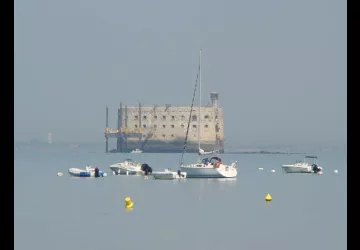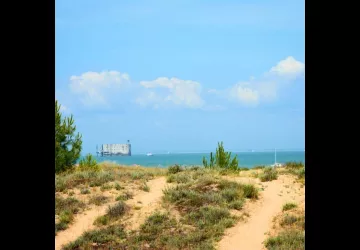Fort Boyard
Dates & opening times
Description
This fort is located in the open sea between the islands of Aix and Oléron, on a sandy shoal. Dutch cartographers, who were the first to mark this spot, called it "Banjaert" ("sandbank" in Dutch). This word later evolved into its current name: "Boyard".
As early as the 17th century, the construction of a defensive system at this location was envisaged to protect the mouth of the Charente - and above all the large Rochefort arsenal - from English naval assaults. Although there were forts on the islands of Aix and Oléron, the range of their cannons was not sufficient for their fire to cross and block this passage for enemy ships.
Vauban, military architect under Louis XIV, was commissioned by the King. Soundings were taken on the boyard lanyard. His response was categorical as to the feasibility of the project: "Sire, it would be easier to grasp the moon with one's teeth than to attempt such a task in this place. The fort project was temporarily shelved.
It was Napoleon Bonaparte who unearthed the project in 1801. At the time, it was estimated to cost 830,000 francs. That same year, preparations began for the construction site. On the island of Oléron, a town adapted to the needs of the project was built. Named "Boyardville", it would accommodate workers during the construction of the future Fort Boyard.
In the end, the construction of the fort cost the French state 8,600,000 francs, and ironically, once completed, Fort Boyard proved to be completely useless!
Having taken so long to build, technical advances in weaponry meant that cannons could now crossfire.
It was used as a prison. In 1913, it was decommissioned and abandoned by the army. In 1961, the Ministry of the Army decided to get rid of it and put it up for sale. It was bought by a Belgian dentist, Eric Aerts.
In 1966, cameras set up for the first time in Fort Boyard, which was used as the backdrop for the final scene of the film "Les Aventuriers", directed by Robert Enrico.
In 1988, Jacques Antoine's production company bought Fort Boyard from Eric Aerts and convinced the Conseil Général de Charente-Maritime to buy it back for a symbolic 1 franc.
The Conseil Général accepted and became the new owner. In exchange, it will take charge of the Fort's restoration, accessibility and maintenance. The production company - for its part - will only be a tenant, and will only be responsible for the costs associated with making the show.
Fort Boyard is not open to the public, so take advantage of a wide range of cruises departing from the Ile d'Oléron (Port de Saint-Denis d'Oléron or Boyardville) to get as close as possible to this majestic stone vessel.
Media files
Characteristics
Charges
Gratuit

